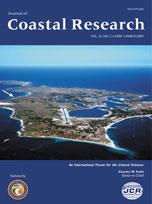Hydrographic data and water samples for suspended matter were taken in the distal mud area in the East China Sea in winter 1997 before a winter storm, right after the storm, and 14 days later. Based on the field hydrographic data and the concentrations of total suspended matter, the effect of the winter storm on the sediment dynamic processes in the mud area was studied. The results show that the tidal currents dominate the hydrodynamic regime in the study area under calm winter weather with certain stratification of the water column. The winter storm caused strong mixing of the water column and destroyed its stratified structure; however, the high concentration of total suspended sediment (TSM) did not appear simultaneously with the well-mixed water column after the storm, as we expected, but 12 hours later. The storm-induced high TSM in the mud area seems to lag in time the occurrence of the storm in the study area. Analysis indicates that the storm cannot resuspend the surface sediment at station 111, but it could resuspend the surface sediment at shallower water depth outside of the mud area and increase the TSM in waters, which can be carried out by the Yellow Sea Coastal Current and transported to the mud area at station 111. The high TSM observed during the winter stormy period on the shelf might not be caused by the local resuspension.
How to translate text using browser tools
1 March 2007
Effect of a Winter Storm on Sediment Transport and Resuspension in the Distal Mud Area, the East China Sea
Zuosheng Yang,
Kun Lei,
Zhigang Guo,
Houjie Wang
ACCESS THE FULL ARTICLE

Journal of Coastal Research
Vol. 2007 • No. 232
March 2007
Vol. 2007 • No. 232
March 2007
continental shelf
Sediment dynamic process
suspended sediment




